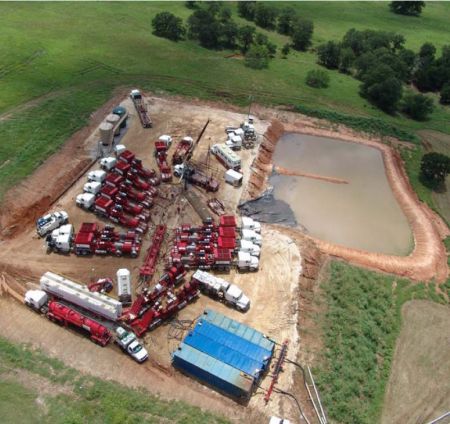“A natural gas well takes up the same space as a two car garage.” So goes a gas industry ad, part of the propaganda campaign Nova Scotians have been treated to over the last year. The claim is true- as far as it goes. But it was intended for soothing our “emotion based” fears of fracking. So it should be looked at in that light.
What Hosting Shale Gas Fracking Would Bring You and Your Community
Unlike a conventional gas well, a single fracked shale gas well can only draw a limited volume from a very limited area. So 6 or 7 producing shale gas wells are packed on to each well pad, and drain about one square kilometre.
There isn't much footprint to a two car garage. And “wellpad” doesn't sound huge does it? But these shale gas multi-well producing “pads” are well over a hundred metres square. With the clustered shale gas wells are a host of large storage tanks and other industrial infrastructure. Along with the much better known threat to water quality comes the air pollution and global warming effects from “fugitive emissions”.
Shale gas production is built up one fracked well at a time, with multiple treatments for some of the wells. Each of those fracking treatments brings additional industrial infrastructure to the wellpad – drilling rigs, multiple tractor trailer pumper units yoked together, waste ponds, and much more than a thousand truck trips in and out.
And that is just one wellpad, which has pipelines running to the neighbouring wellpads... about a kilometre away in each direction. This gets repeated across the landscape, adding in noisy 24/7 compressor stations to service the pipelines of several wellpads. A fully developed producing shale gas field has 200 to 300 wells, with all the industrial infrastructure that entails. At any given time, several of the wellpads will have yet another active hyper-industrial high volume hydraulic fracturing process to put in a new well, or frack again an existing well.
Triangle Petroleum's Development Plan for Northern Hants County
That typical industrial infrastructure for shale gas production was described and mapped for the Kennetcook and Noel area in Triangle Petroleum's June 2008 Development Plan application for the Production Lease it now holds.
From 2007 to 2009 Triangle drilled five wells three, three of them wells receiving high volume hydraulic fracturing treatment. Residents assumed that Triangle gave up because not enough gas was found.
Unfortunately for residents of the communities, this is not at all the case.
The Economics of Shale Gas Extraction: How it Works
Small companies like Triangle Petroleum are the front end of shale gas development. To continue, they depend on investors and co-venturing partners. The company came to Nova Scotia in 2007- at the height of the shale gas frenzy. But the hyper-inflated shale gas bubble was already letting out air by 2008, and industry investors deserted just opening frontiers like the Martimes Basin Shale. Quite simply, without investors Triangle Petroleum had no choice but to shelve on its Hants County shale project. So they stopped in the middle of their 2009 drilling program.
Gas prices have very recently begun rising. It is only a matter of time until fracking in Nova Scotia is economically viable again- a lot sooner if the proposed Goldboro liquified natural gas plant continues to inch forward. While putting the media to sleep with its token 'Review of Hydraulic Fracturing,' the NDP government quietly encourages the industry about the potential for high volume hydraulic fracturing in Nova Scotia.
The minute the green light for fracking goes back on in Nova Scotia, Triangle will have buyers lining up to kick the tires of its Production Lease. One of them will buy it and pick up where Triangle left off: the initial stages of working towards that typical producing field of well over 200 wells, meanwhile scouting around for other prospective producing shale gas industrial sites.
Paint the bulls eye back on Kennetcook and Noel.
UPDATED: See also Fracking Nova Scotia? Oil industry confirms Kennetcook and Noel in the crosshairs



